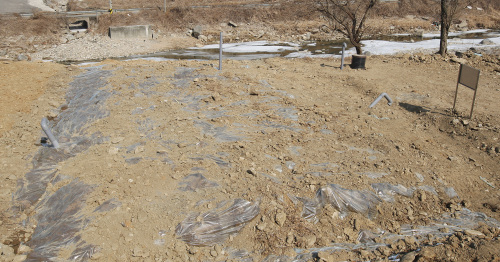One in three sites in region poses risk of contaminants leaking into waterways
About one out of every three sampled burial sites near the Han River for animals slaughtered to prevent spread of foot-and-mouth disease needs additional measures to block leakage of contaminants, the Ministry of Environment said Thursday.
But the authorities confirmed that the water from the vicinity, which is the source of tap water used in Seoul and the metropolitan area, is safe.
The administration researched 83 sampled sites of Gyeonggi, Gangwon and North Chungcheong provinces, which are located near the upper region of the Han River. They concluded that 27 were in need of “repair” due to the possibility of secondhand contamination.
About one out of every three sampled burial sites near the Han River for animals slaughtered to prevent spread of foot-and-mouth disease needs additional measures to block leakage of contaminants, the Ministry of Environment said Thursday.
But the authorities confirmed that the water from the vicinity, which is the source of tap water used in Seoul and the metropolitan area, is safe.
The administration researched 83 sampled sites of Gyeonggi, Gangwon and North Chungcheong provinces, which are located near the upper region of the Han River. They concluded that 27 were in need of “repair” due to the possibility of secondhand contamination.

The government will put 1.4 billion won ($1.2 million) into installing preventative walls and extra layers of plastics around the pit to block leachate with various contaminants leaking to surrounding soils. Chung Eun-hae, a ministry official, said the authorities will establish water utility services in the regions so that residents will not have to use ground water.
“We will strive to protect the water resource from any possible contamination,” Chung said. “I can assure you that salmonella, bacillus and other viruses as well as microbes and nitrate nitrogen will be filtered when used for tap water,” she said.
The ministry’s announcement came as concerns mounted over the possible secondhand damage, where the water and contaminants leak through plastic wrapping around the dead animals. When the weather become warmer the soil around the burial sites may collapse, exposing the unhygienic carcasses to the air and causing huge environmental disaster, observers claimed.
“We will have to see when the side effect of the mass burial will prevail. It may take years and it may not,” Chung told reporters.
As the report suggested, sloppy FMD measures have become the subject of criticism. A previous investigation by the ministry showed that 61 out of 750 burial sites in North Gyeongsang Province were slack in fulfilling their duties. Observers are becoming more suspicions about other regions, too.
On Feb. 12, Agriculture Minister Yoo Jeong-bok, gasped after observing a burial site in Hwacheon, Gangwon Province, which was selected as an example of good FMD control.
Yoo spotted that basic protocols were violated: The supposedly-five meter pit was dug to one meter only and the pipe installed to emit toxic gas from carcasses was out of order.
“Don’t you know the manuals?” he yelled. Local officials said that the ground was frozen and that they could not dig a deep hole, but Yoo admitted the countermeasure was a failure. He offered to resign after the FMD whirlwind subsides.
The FMD, which resulted in the slaughter of more than 3.5 million pigs and cows ― the simultaneous outbreak of the avian influenza caused the culling of 6 million poultry ― is expected to incur more than 3 trillion won damage for farmers.
Secondhand economic damage is also forecast as some correlated industries are staggering over the slaughter. From pharmaceuticals providing antibiotics for livestock to restaurants cooking their meats, co-dependent industries are heavily hit by the sudden depression.
The Donga Ilbo estimated 265 million won damage would hit the local economy of Andong, North Gyeongsang Province, per slaughter of 200 cows in a farm in the region.
“I say half of the cattle farm owners are now on the brink of going bankrupt. It is destroying local agricultural industry,” Lee Gwang-seok, head of the Korean Farm Bureau Federation, said as he protested the government’s lack of enthusiasm toward the issue.
By Bae Ji-sook (baejisook@heraldcorp.com)



















